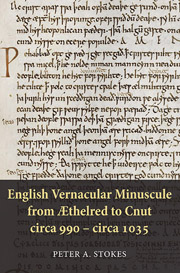Book contents
- Frontmatter
- Contents
- Lists of Tables
- Lists of Figures
- Lists of Plates
- Acknowledgements
- List of Abbreviations
- Introduction
- 1 Background
- 2 Attributions of Origin
- 3 Scribal Change in Bookhands and Charters: The ‘Tall and Narrow’ Hands
- 4 Scribal Continuity in Bookhands and Charters: The ‘Square-Influenced’ Hands
- 5 Glosses and Scribbles
- Conclusion: Change and Continuity in Early English Vernacular Minuscule
- Appendix. List of Scribal Hands
- Glossary
- Bibliography
- Index of Manuscripts and Charters
- General Index
- Plate section
2 - Attributions of Origin
Published online by Cambridge University Press: 05 April 2014
- Frontmatter
- Contents
- Lists of Tables
- Lists of Figures
- Lists of Plates
- Acknowledgements
- List of Abbreviations
- Introduction
- 1 Background
- 2 Attributions of Origin
- 3 Scribal Change in Bookhands and Charters: The ‘Tall and Narrow’ Hands
- 4 Scribal Continuity in Bookhands and Charters: The ‘Square-Influenced’ Hands
- 5 Glosses and Scribbles
- Conclusion: Change and Continuity in Early English Vernacular Minuscule
- Appendix. List of Scribal Hands
- Glossary
- Bibliography
- Index of Manuscripts and Charters
- General Index
- Plate section
Summary
Any detailed palaeographical analysis of the sort proposed here depends on a firm base of dated and localised manuscripts. Such a base can be difficult to build, however, particularly for the Anglo-Saxon period, from which so little survives and that which does is often subject to numerous conflicting attributions from different scholars at different times; these attributions can then be cited over and over in subsequent scholarship which does not necessarily consider the uncertainties expressed in the original attribution, and sometimes not even subsequent strong counter-arguments. The purpose of this chapter is therefore to work systematically through the corpus, reevaluating the evidence for attribution and attempting to establish a set of relatively firm grounds from which the remainder of this study can proceed. It is arranged according to the types of evidence presented by Neil Ker in his Medieval Libraries of Great Britain and therefore proceeds approximately in order of decreasing confidence of attribution.
Colophons and Inscriptions
Relatively few Anglo-Saxon manuscripts contain colophons, and even fewer of those colophons belong to scribes of vernacular texts. Ten manuscripts under consideration here contain colophons, only half of which contain any concrete information about the scribe. One of the more useful of these is on 45v of CCCC 140, where the scribe named himself as Ælfric of the monastery at Bath and dedicated the book to one Brihtwoldo preposito.
- Type
- Chapter
- Information
- Publisher: Boydell & BrewerPrint publication year: 2014



